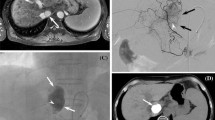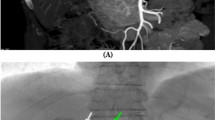Abstract
Purpose
To analyze the origins of the feeding arteries of hepatocellular carcinomas (HCCs) near the umbilical fissure of the left hepatic lobe.
Methods
Twenty-eight HCCs with a mean ± SD tumor diameter of 3.4 ± 1.0 cm (range 1–4.4 cm) in contact with the right or left side of the umbilical fissure were treated by superselective transcatheter arterial chemoembolization (TACE). The origins of the tumor-feeding arteries were analyzed with arteriograms and computed tomography or cone-beam computed tomography images obtained during and 1 week after TACE.
Results
Twenty-one HCC lesions were located in segment 3 and seven were located in segment 4. Of 21 tumors in segment 3, 13 (61.9%) were supplied by the lateral inferior subsegmental artery (A3), three (14.3%) by the medial subsegmental artery (A4), three (14.3%) by both A4 and A3, one (4.8%) by a branch arising from the left lateral hepatic artery, and one (4.8%) by a branch of the right gastric artery. In particular, all tumor-feeding branches arising from A4 were the first branch of A4. Of seven tumors in segment 4, four (57.1%) were supplied by A4 and three (42.9%) by A3. In particular, all tumor-feeding branches arising from A3 were the first branch of A3.
Conclusion
This study demonstrates crossover blood supply to HCC lesions located near the umbilical fissure, in addition to direct feeding from a separate branch. In particular, the first branch of the opposite subsegmental artery may feed tumors when crossover blood supply is present.






Similar content being viewed by others
References
Yamada R, Sato M, Kawabata M et al (1983) Hepatic artery embolization in 120 patients with unresectable hepatoma. Radiology 148:397–401
Uchida H, Ohishi H, Matsuo N et al (1990) Transcatheter hepatic segmental arterial embolization using lipiodol mixed with an anticancer drug and Gelfoam particles for hepatocellular carcinoma. Cardiovasc Intervent Radiol 13:140–145
Matsui O, Kadoya M, Yoshikawa J et al (1993) Small hepatocellular carcinoma: treatment with subsegmental transcatheter arterial embolization. Radiology 188:79–83
Miyayama S, Matsui O, Yamashiro M et al (2007) Ultraselective transcatheter arterial chemoembolization with a 2-F tip microcatheter for small hepatocellular carcinomas: relationship between local tumor recurrence and visualization of the portal vein with iodized oil. J Vasc Interv Radiol 18:365–376
Couinaud C (1954) Lobes et segments hépatiques: notes sur I’architecture anatomique et chirurgicale du foie. Presse Med 62:709–712
Bismuth H (1982) Surgical anatomy and anatomical surgery of the liver. World J Surg 6:3–9
Gupta SC, Gupta CD, Arora AK (1977) Subsegmentation of the human liver. J Anat 124:413–423
Reichert PR, Renz JF, D’Albuquerque LAC et al (2000) Surgical anatomy of the left lateral segment as applied to living-donor and split-liver transplantation: a clinicopathologic study. Ann Surg 232:658–664
Renz JF, Reichert PR, Emond JC (2000) Biliary anatomy as applied to pediatric living donor as split-liver transplantation. Liver Transplant 6:801–804
Cho A, Gunji H, Koike N et al (2007) Intersegmental arterial communication between the medial and left lateral segments of the liver. Dig Surg 24:328–330
Chen RC, Chou CT, Chen WT et al (2011) Delineation of the watershed between right and left hepatic arterial territories with carbon dioxide-enhanced ultrasonography. J Vasc Interv Radiol 22:667–672
Takeda T, Ido K, Yuasa Y et al (1988) Intraarterial digital subtraction angiography with carbon dioxide: superior detectability of arteriovenous shunting. Cardiovasc Intervent Radiol 11:101–107
Conflict of interest
The authors declare that they have no conflict of interest.
Author information
Authors and Affiliations
Corresponding author
Rights and permissions
About this article
Cite this article
Miyayama, S., Yamashiro, M., Shibata, Y. et al. Origins of Feeding Arteries of Hepatocellular Carcinoma Located Near the Umbilical Fissure of the Left Hepatic Lobe: Angiographic Evaluation. Cardiovasc Intervent Radiol 35, 1380–1387 (2012). https://doi.org/10.1007/s00270-011-0328-2
Received:
Accepted:
Published:
Issue Date:
DOI: https://doi.org/10.1007/s00270-011-0328-2




